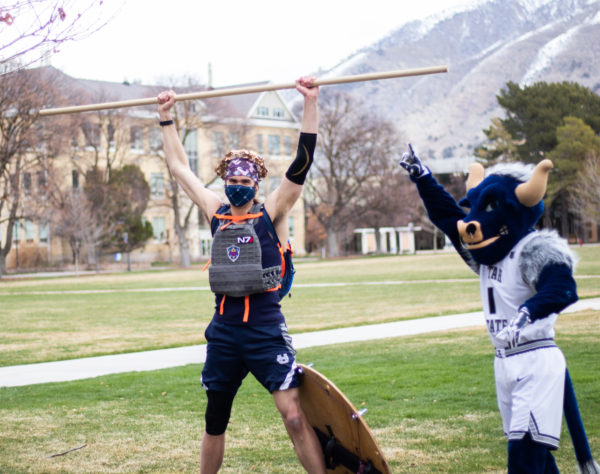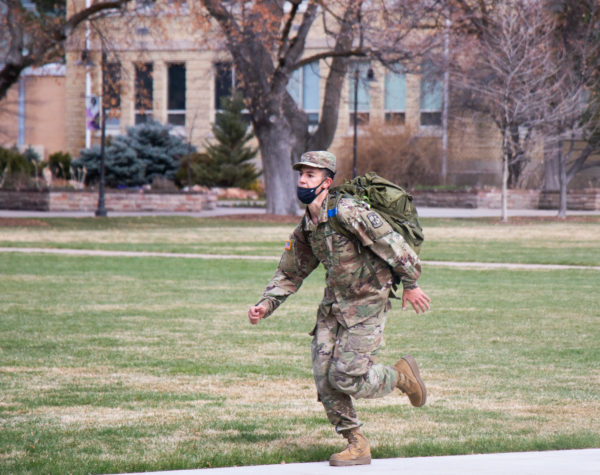Greek battle reenacted on Quad for research project
The Quad was home to a modern reenactment of the Battle of Marathon Friday afternoon.
Daniel Porter, a senior majoring in history, sprinted across the field with a shield, wooden staff, weighted vest and full backpack. A crowd of students, professors and Big Blue cheered the runners, which included several ROTC cadets, as they finished their 1.3-mile charge at Old Main.
The demonstration was the final event of CHaSS week and celebrated Porter’s year-long research project studying the Battle of Marathon. According to the historian Herodotus, Athenian soldiers in this battle charged a mile in full armor to rout an invading Persian force in 490 B.C.
When Porter read about the battle in professor Frances Titchener’s Greek class last spring, she asked him if he thought the arduous run was actually possible.
“I initially responded no, I did not think that they’d be able to make the run and then fight,” Porter said. “And then as I thought about it, I wanted to test it for myself.”
According to Porter’s research, an average Greek citizen-soldier in 490 B.C. would be about 5 feet, 5 inches tall and 150 pounds. The extra weight carried with armor and weapons could be anywhere from 28 to 45 pounds, or a third of the soldier’s bodyweight.
Because Porter is 6 feet, 8 inches tall and 206 pounds, his goal was to run with 73 pounds of extra weight, distributed between his shield, pack and wooden staff, which represented a spear. He also lengthened the run to 1.3 miles, to account for his larger stature.
Porter began training in May 2020, running four miles with an extra 13.5 pounds five days a week. After realizing this was too intensive for him, he modified his training plan to do a five-mile run, a six-mile run, and scale the Old Main stairs every week, adding 5 more pounds every two weeks. He continued this until reaching 73 pounds, at which point he began moving weight to his arm to get used to holding a shield. He completed his training three weeks before Friday’s event.
His research also led him to work with the kinesiology and health department at USU to monitor statistics like oxygen intake during his runs.
 Bailey Rigby
Bailey Rigby Daniel Porter, a senior history major, presents his culmination of a year’s worth of undergraduate research.
The ROTC got involved when Porter was researching the diets of ancient Greek soldiers in August 2020. He reached out to the corps to find out more about modern-day military diets and was invited to train with them. Every Tuesday, Porter joined the cadets to get personal military training experience.
In return, Porter invited them to join for the festivities. Cadet Trevor Hartvigsen was on road guard to make sure participants were safe.
“It’s always cool to see the camaraderie with our cadets,” Hartvigsen said. “And it’s really nice to be able to work with the history department. As a history major myself, it was really cool to see both of the groups that I work with really closely working together.”
Titchener was Porter’s mentor for the project. She was inspired by the project of former student Daniel Bertrand with his mentor, Susan Cogan. They worked to create a full-size trebuchet that sat on the Quad in March 2019.
While Titchner and Porter tried to make the run as accurate as possible, she said there was one thing missing.
“We can’t replicate one of the most crucial elements, and that is, when you’re running, not just for your life, but your family and being enslaved: some terrible, terrible things, not just losing,” Titchener said. “What would that do? You would burn through every bit of energy.”
Both Titchener and Cogan hope that this type of hands-on, experiential learning continues to grow at USU.
“Historians have labs, too. Most of the time, we are in an archive, like special collections in the library, working with rare books or manuscripts,” Cogan said. “But this is, I think, a really exciting frontier for studying history in a new and different way.”
 Bailey Rigby
Bailey Rigby An ROTC cadet finishes their 1.3-mile run to reenact the the Battle of Marathon.
Porter used an URCO grant to help fund his research. He encouraged other students to get involved with undergraduate research.
“It’s a really great opportunity and a way to dive into a topic that you’re interested in on your own,” Porter said.
As for the feasibility of ancient Greeks charging a mile in full armor? Porter says it’s doable, but it would have been close, based on his research.
“Right after today’s run, I felt very good. I’m not sure about combat, but I ran tests last week with exercise science,” Porter said. “According to those tests, it would have been really, really close.”
@nelsonalek

